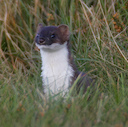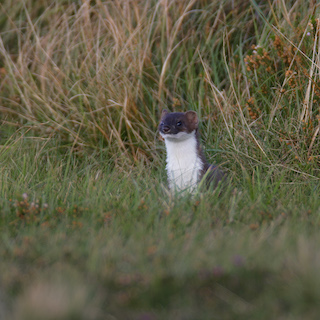 Windmill Farm is a good place to see Stoats.
Windmill Farm is a good place to see Stoats.
Photo: Richard Birchett
Scientific name: Mustela erminea
Other common names: Short-tailed Weasel, Ermine (when in its white winter coat)
Cornish name: Yewgenn, Ermin
Conservation status: Stoats are not legally protected in the UK, although they are in Ireland
What to look for:
• Appearance and colouring: Orange-brown fur in summer with a white throat and belly and black-tipped tail. Further north, its winter coat is pure white with a black-tipped tail, but this colour change does not usually occur further south within its range. The body is long, thin and low-slung.
• Size: Length 24 to 32 cm.
• Where: Meadows, grassland, woods and hedges. Widespread in the UK, though absent from the Isles of Scilly.
 Here in Cornwall, it would be a very rare thing to see the transformation for which the Stoat is famous. Further north, its autumn moult alters this feisty predator from nut brown to white ermine. The change is, however, triggered by cold temperatures (it’s essentially a camouflage against snow), so in our milder climes the winter Stoat, though paler than in summer, is certainly not white. (Having said that, a Stoat with a full ermine coat did turn up in north-east Cornwall in 2013, as noted in The Mammals of Cornwall and the Isles of Scilly.)
Here in Cornwall, it would be a very rare thing to see the transformation for which the Stoat is famous. Further north, its autumn moult alters this feisty predator from nut brown to white ermine. The change is, however, triggered by cold temperatures (it’s essentially a camouflage against snow), so in our milder climes the winter Stoat, though paler than in summer, is certainly not white. (Having said that, a Stoat with a full ermine coat did turn up in north-east Cornwall in 2013, as noted in The Mammals of Cornwall and the Isles of Scilly.)
The Stoat belongs to the Mustelid family, which also includes the smaller Weasel, as well as the Otter and Badger. You may catch sight of one as a flash of russet-orange fur as it bounds across a field with its loping stride, or disappears into a hedge and out of sight. Small it may be, but it’s a fierce predator, catching rabbits (which are five times its size) as well as smaller rodents. They hunt along field edges, hedgerows and walls, avoiding being in the open. Stoats will climb trees to raid bird nests, and follow rodents into their burrows.
Males and females do not live together. They use the dens of their prey (often several dens), and scent-mark their territory. In spring, the males range further afield search for females. After mating, the female does not give birth to her litter of kits until the following spring. The female is not pregnant the whole time: in common with many other mammals, Stoats use a strategy called delayed implantation, with the fertilised eggs being held dormant for around ten months. Gestation is for around four weeks, and the kits are fed by their mother for two to three months while they learn to hunt.
Did you know…?
…Stoats were introduced to New Zealand in the nineteenth century in a bid to control the rabbit population. Unfortunately, this is bad news for native birds there, which are also predated by the Stoats.
…Ermine was much prized; in Europe, ermine fur used to be a symbol of royalty.
More information and references:
Cornwall Mammal Group, 2013. The Mammals of Cornwall and the Isles of Scilly (edited by David Groves). Environmental Records Centre for Cornwall and the Isles of Scilly (ERCCIS), Cornwall.
Published: October 2020
Author: Amanda Scott
Photo: Richard Birchett (website, YouTube)
